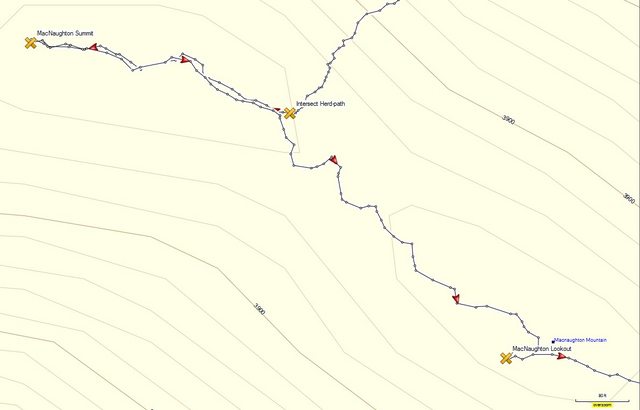dom15931
New member
Results of the "ALL CAPS" at the end.
Having completed all 46 and knowing the story behind the "fallen four" and the mystery surrounding MacNaughton mountain and the lack of a clear and modern method, to my knowledge, of a measure of it's true elevation, on May 29th 2016 I set out to A. Conquer the peak, and, B. Take high-accuracy RTK GPS measurements of the summit elevation which results I intend to present to the NGS/USGS for review and hopefully a field verification.
I left the ADK Loj Visitors Center parking lot at a late but well rested 10:30am. I would have good luck with the weather all day encountering no local impacts of thunderstorms. It was hot though, but not quite as bad as the day before and the nearby storms would cool things off. I arrived at Rocky Falls to still sunny weather with only a handful of people, unlike the previous day in the Mac's which was like a Black Friday at the mall of sorts with it crowds, enough so that I was probably one of ten people to do the Shepard's Tooth that day. Ahhh... Much less people. The conditions on the trail were dry and I was leisurely going about 1.8 miles an hour or so, breaks included, through this and the first half of the trail to Wallface Ponds. I didn't want to rush in the heat as it just exponentially increases water consumption with the unusually high temperatures.
The second half of the trail to Wallface Ponds...ugh...what a mess. It was slow going while trying not to sink to my knees in mud. Most heard paths are better maintained even if naturally. It a series of long-untrimmed pathways and stretches of swampy bogs that can, and on the way back did, send you in circles! A light, but pleasant rain was falling and had been for a light while. Thunder rumbled in the distance all around me, but today the mountain gods were on my side it would seem.
I never found a clear heard path at the base of the mountain and did not search too hard. I just aimed for a compass bearing nearing the center of the ridge as the gain amount isn't too bad. Man did I luck out as going up I had a pleasant and very not technical route up the mountain. No huffing and puffing or obstacles to deal with. I arrived at the summit ridge not knowing my location. The GPS I had on me was packed safely away and was not being used at any point monitor my traveling locations. I walked out to the far side of the ridge, not knowing if I had walked by the summit and then headed back to find the summit sign. I looked at the cellular devices I had on me. Net10 had a decent internet connection. Verizon was in and out. T-Mobile had a reliably steady 4G connection.
"4G MacNaugton on my smart phone, now how cool is that?"
Really cool, actually, but not for surfin the web, messaging friends or social media posting!
A cellular network with internet can be used to dial in and create a Virtual-Reference-Station (VRS) in the absence of a physical base station with the proper equipment. This allows for Real Time Kinematic corrections of about two dozen potential satellites with these types of GPS. You may see these setups on survey crews laying out roadway construction points or controlling large equipment. I am not up here with a hand-held unit, but the type of setup the USGS would use to do the same.
While on my walk out I screwed up not once but twice, first by poorly and arrogantly descending without watching my bearing causing an unnecessary southward decent and 500' drop and then later understandably struggling in the bogs and spinning circles for an hour in the dark one thing made the travel easier and worth the struggle was that:
On the summit I repeatedly observed the same result of the output from the GPS at both the summit sign and the assumed summit rock nearby averaging approx 180 RTK "FIXED" readings each:
NYSP East NAD 83 CONUS NAVD 88 Geoid 12(A) Elevation=
4004.4137,Summit Sign
4004.3118,Summit Sign Check
4004.3096,Summit Sign Check
4004.4218,Summit Sign Check
4005.4922,Summit Rock
4005.2703,Summit Rock Check
4005.3035,Summit Rock Check
4005.3349,Summit Rock Check
All positions max VRMS of 0.3', or 4 inches, allowed into averaging. The same result was re-calcuated, statistically, at each location each time. Google Earth's terrain model was what made me choose to check MacNaughton (it has the summit around 4014') along long with the known errors in the region. In short, there was reason to believe that it was actually over 4,000.
The work is in process of being submitted to the appropriate agencies for review, comment.
4 may have fallen, but hopefully ONE will be raised.
-Dom
Last edited:






















![Grand Teton Day Hikes and National Park Map [Map Pack Bundle] (National Geographic Trails Illustrated Map)](https://m.media-amazon.com/images/I/41DB0jvRnbL._SL500_.jpg)







![Grand Canyon, North and South Rims [Grand Canyon National Park] (National Geographic Trails Illustrated Map)](https://m.media-amazon.com/images/I/419Y-ycyVUL._SL500_.jpg)
![Yellowstone National Park [Map Pack Bundle] (National Geographic Trails Illustrated Map)](https://m.media-amazon.com/images/I/51kGuJ72qjL._SL500_.jpg)





























